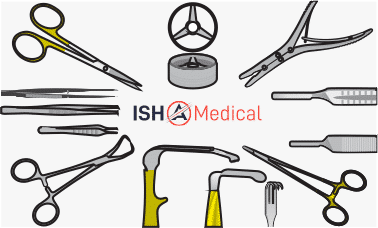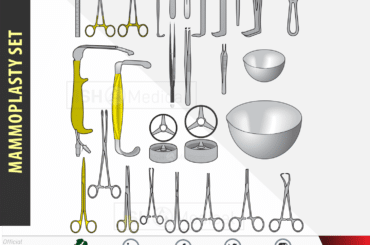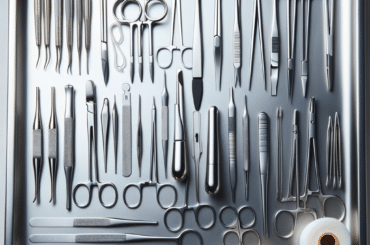P
What are Plastic Surgery Instruments?
As the name suggests, plastic surgery instruments are specialized tools and devices that plastic surgeons use to perform an extensive range of cosmetic and reconstructive surgical procedures. These instruments are meticulously designed to facilitate the surgeon’s work. Also, ensuring precision, safety, and optimal outcomes for patients.
Intended Use of Plastic Surgery Instruments
The intended use of plastic surgery instruments encompasses a wide range of functions and tasks required during plastic and reconstructive surgical procedures. These specialized instruments are designed to aid plastic surgeons in achieving precise, safe, and aesthetically pleasing patient outcomes. Let’s delve deeper into the intended uses of these instruments:
-
Incision and Dissection:
- Plastic surgeons often need to make precise incisions and carefully dissect tissues. Instruments like scalpels and dissectors are used for these purposes. Scalpels create clean and controlled incisions, while dissectors help in separating and manipulating tissues with minimal trauma.
-
Hemostasis:
- Controlling bleeding is crucial in any surgical procedure. Plastic surgery instruments like hemostatic forceps and electrocautery devices are employed to achieve hemostasis. Hemostatic forceps allow surgeons to grasp and ligate blood vessels, while electrocautery devices use heat to coagulate blood vessels and tissues, minimizing bleeding.
-
Tissue Manipulation and Grasping:
- During plastic surgery, surgeons often need to manipulate, reposition, or hold tissues in place. Forceps, tissue hooks, and retractors are essential tools for these tasks. Forceps allow for precise tissue manipulation, while retractors hold back tissues to provide a clear view of the surgical area.
-
Suturing:
- A secure and aesthetically pleasing closure is fundamental to plastic surgery. Specialized needles, suture materials, and needle holders are used to create well-placed sutures. Needle holders provide surgeons with control and precision when passing sutures through tissues.
-
Fat Grafting:
- Procedures such as liposuction and fat grafting involve the extraction and injection of fat for contouring and augmentation. Cannulas and syringes are used to extract and inject fat cells precisely.
-
Implantation:
- Implants may be used in procedures like breast augmentation or facial reconstruction. Instruments like implant sizers and dissectors aid in implant placement and ensure that the chosen implant size and position align with the patient’s goals and anatomical features.
-
Tissue Preparation:
- Preparing tissues for grafting or transplantation requires specialized instruments like dermatomes and skin graft knives. These tools help create uniform and thin grafts for grafting procedures.
-
Suction Devices:
- Suction devices are used to remove fluids, blood, and debris from the surgical field, ensuring a clear and unobstructed view for the surgeon. This is particularly important in procedures where visibility is critical.
-
Bone Work:
- In procedures involving bone manipulation or reconstruction, instruments like bone saws and bone chisels may be used to shape and position bones according to the desired outcome.
-
Facial Contouring:
- In facial plastic surgery, instruments like mallets and chisels are used for contouring bones and achieving facial symmetry.
-
Laser and Energy Devices:
- Some plastic surgery procedures, such as skin resurfacing and scar revision, may involve the use of laser and energy-based devices for precise tissue modification.
In summary, plastic surgery instruments are meticulously designed to cater to the unique demands of plastic and reconstructive surgery. They serve a multitude of purposes, from making precise incisions to achieving hemostasis, manipulating tissues, suturing, and ensuring the best possible cosmetic and functional outcomes for patients. The choice of instruments depends on the specific procedure and the surgeon’s preference, emphasizing the importance of skill and expertise in their use.
Types of Plastic Surgery Instruments
Plastic surgery instruments encompass a diverse range of specialized tools and devices designed to assist plastic surgeons in performing various cosmetic and reconstructive procedures with precision and safety. In the same way, these instruments are tailored to specific tasks and are essential for achieving optimal surgical outcomes. Below are some of the common types of plastic surgery instruments, categorized by their intended use:
Incision and Dissection Instruments:
- Scalpels: Precision cutting instruments used for making incisions. Also, they come in various sizes and shapes to accommodate different surgical needs.
- Surgical Scissors: Designed for cutting tissues, sutures, and other materials. Also, they are available in straight, curved, and fine-tipped varieties for delicate work.
Dissectors: Used to separate and manipulate tissues during surgery, ensuring minimal trauma.
Hemostatic Instruments:
- Hemostatic Forceps: Specialized forceps designed to grasp and ligate blood vessels, controlling bleeding during surgery.
- Electrocautery Devices: Utilize heat or electrical current to coagulate blood vessels and tissues, minimizing bleeding.
Tissue Manipulation and Grasping Instruments:
- Forceps: Versatile instruments used for grasping tissues, sutures, or other objects. Different types include Adson forceps, tissue forceps, and hemostatic forceps.
- Retractors: Instruments used to hold back tissues and create a clear view of the surgical site. Varieties include self-retaining retractors and hand-held retractors.
- Tissue Hooks: Assist in gently manipulating tissues, aiding in dissection and repositioning.
Suturing Instruments:
- Needle Holders: Designed to securely grasp and manipulate needles during suturing, providing control and precision.
- Suture Materials: Various types of sutures are used, such as absorbable and non-absorbable sutures, depending on the specific procedure.
Fat Grafting Instruments:
- Liposuction Cannulas: Hollow tubes used to suction out fat from the body during liposuction procedures.
- Syringes: Used for extracting and injecting fat cells precisely in fat grafting procedures.
Implantation Instruments:
- Implant Sizers: Instruments to help surgeons choose the appropriate implant size during procedures like breast augmentation.
- Implant Dissectors: Used to create a pocket for implant placement and ensure proper positioning.
Dermatomes and Skin Graft Knives:
- Dermatomes: Instruments used for creating uniform and thin grafts from the donor site for grafting procedures.
- Skin Graft Knives: Precise knives for cutting and shaping grafts.
Suction Devices:
- Suction Cannulas: Instruments used to remove fluids, blood, and debris from the surgical field, ensuring optimal visibility during surgery.
Bone Instruments:
- Bone Saws: Used for cutting bones during facial and craniofacial surgeries.
- Bone Chisels and Mallets: Instruments for shaping and contouring bones to achieve desired facial symmetry.
Facial Contouring Instruments:
- Chisels: Employed for fine-tuning bone structures in facial plastic surgery.
- Mallets: It is used in conjunction with chisels for precise facial contouring.
Laser and Energy-Based Devices:
- Laser Handpieces: Instruments for performing laser skin resurfacing, scar revision, and other laser-based procedures.
- Electrosurgical Devices: Utilized for precise tissue modification and coagulation using electrical energy.
For your information, these are just some examples of the many plastic surgery instruments available, each tailored to specific surgical needs and techniques. In the same way, the selection of instruments depends on the type of procedure, the surgeon’s expertise, and the desired outcome, emphasizing the importance of skill and precision in their use.
Types of Plastic Surgery Sets
Plastic surgery sets, also known as surgical instrument sets or kits, are collections of specialized surgical instruments and tools organized to meet the needs of specific plastic and reconstructive surgical procedures. Further, these sets are carefully curated to ensure that surgeons have access to the appropriate instruments for each surgery.
-
Here are some common types of plastic surgery sets:
-
Facial Plastic Surgery Set:
- They are designed for procedures involving the face, such as rhinoplasty (nose surgery), facelifts, eyelid surgery, and facial implants.
- This set includes instruments like nasal rasps, septal instruments, facial scissors, micro dissectors, and various forceps for precise facial work.
-
Breast Surgery Set:
- It is tailored for breast augmentation, breast reduction, breast lift (mastopexy), and breast reconstruction procedures.
- Breast surgery sets contain instruments like breast retractors, tissue dissectors, implant sizers, and breast scissors.
-
Liposuction Set:
- They are used in liposuction procedures to remove excess fat from various body areas.
- Includes liposuction cannulas of various sizes and shapes, suction tubing, and infiltration instruments for administering tumescent anesthesia.
-
Tummy Tuck (Abdominoplasty) Set:
- It contains instruments like abdominal retractors, tissue scissors, and suturing instruments.
-
Body Contouring Set:
- They are used in procedures like body lifts, thigh lifts, and arm lifts to improve body contour and remove excess skin.
- It includes a variety of retractors, scissors, and suturing instruments suitable for different body areas.
-
Hand Surgery Set:
- Designed for hand surgeries, including procedures to repair fractures, reconstruct soft tissues, or correct congenital deformities.
- Hand surgery sets contain hand-specific instruments like hand-held retractors, bone instruments, and microsurgical tools.
-
Craniofacial Surgery Set:
- They are used for complex surgeries involving the craniofacial region, such as craniosynostosis correction or craniofacial trauma repair.
- It includes specialized craniofacial instruments like cranial drills, cranial distractors, and bone fixation devices.
-
Skin Grafting Set:
- They are designed for procedures involving the transplantation of skin grafts.
- The skin grafting set contains dermatomes for graft harvesting, skin graft knives, and instruments for graft placement.
-
Microsurgery Set:
- Tailored for microvascular and microsurgical procedures, often used in reconstructive surgeries requiring precise tissue anastomosis (joining).
- Microsurgery set includes microsurgical instruments like microforceps, microscissors, and microneedle holders.
-
Burn Surgery Set:
- They are used in the treatment of burn injuries, including debridement and skin grafting.
- It contains instruments for burn wound preparation, tissue excision, and grafting.
-
Rhinoplasty Set:
- The Rhinoplasty set contains all the necessary tools for reshaping the nose and correcting functional issues.
- It includes nasal instruments such as nasal scissors, rasps, and septal instruments.
-
Otoplasty Set:
- It is designed for ear surgery, typically for correcting prominent ears or other ear deformities.
- It contains ear-specific instruments like ear retractors, scissors, and ear sculpting instruments.
In short, these are some of the most common types of plastic surgery sets, each tailored to the unique requirements of specific procedures. Surgeons and surgical teams carefully select the appropriate set based on the surgery they will be performing, ensuring that they have access to the necessary instruments for a successful outcome.
How to select the best Plastic Surgery Instruments
Selecting the best plastic surgery instruments is crucial for achieving optimal surgical outcomes and ensuring patient safety. Surgeons and healthcare facilities must consider various factors when choosing these instruments. Here are key steps and considerations to help select the best plastic surgery instruments:
Understand the Surgical Procedure:
- Start by thoroughly understanding the specific surgical procedure you will be performing. Also, different procedures require different sets of instruments.
Consult with Surgeons and Experts:
- Seek input from experienced plastic surgeons and surgical teams who regularly perform the procedure. They can provide valuable insights into the instruments they prefer and the ones that work best for specific tasks.
Review Instrument Quality:
- Ensure that the instruments meet high-quality standards. Look for instruments made from durable materials (e.g., stainless steel) to ensure longevity and resistance to corrosion. Instruments should also be easy to clean and sterilize.
Check for Regulatory Compliance:
- Ensure that the instruments meet regulatory standards and are compliant with applicable guidelines and certifications, such as those from the FDA (U.S. Food and Drug Administration) or other relevant authorities in your region.
Consider Ergonomics:
- Ergonomically designed instruments can reduce surgeon fatigue and improve precision during surgery. Instruments with comfortable handles and user-friendly designs can make a significant difference.
Evaluate Instrument Sets:
- Opt for instrument sets explicitly designed for the procedure you will be performing. Also, these sets are carefully curated to include the necessary instruments and minimize the risk of missing critical tools.
Choose Instruments from Reputable Manufacturers:
- Stick to instruments produced by reputable manufacturers known for their quality and reliability. Also, established brands often invest in research and development to improve instrument design and performance.
Customize as Needed:
- In some cases, it may be necessary to customize instrument sets to accommodate specific surgeon preferences or unique aspects of a procedure. Discuss customization options with instrument suppliers.
Consider Cost and Budget:
- While quality should be a top priority, consider the cost of the instruments and how they fit within your budget. Compare prices from different suppliers and weigh them against the instruments’ quality and functionality.
Warranty and Customer Support:
- Inquire about warranties and customer support offered by the instrument supplier. Also, this can be crucial in case of defects or issues with the instruments.
Sterilization Compatibility:
- Ensure that the selected instruments can be effectively sterilized using the methods approved by your healthcare facility, such as autoclaving or chemical sterilization.
Seek Feedback and Reviews:
- Research online reviews and ask for feedback from colleagues who have experience with the instruments you are considering. Also, real-world experiences can provide valuable insights.
Trial and Training:
- Conduct trials or training sessions with the selected instruments to assess their suitability and get comfortable with their use.
Sustainability and Environmental Impact:
- Consider the environmental impact of the instruments, such as their disposal and sustainability. Some healthcare facilities are adopting eco-friendly practices, so inquire about instrument recycling or reuse programs.
Compliance with Infection Control Measures:
- Ensure that the instruments comply with infection control measures and guidelines to reduce the risk of surgical site infections.
By carefully considering these factors and involving experienced surgeons and healthcare professionals in the decision-making process, you can select the best plastic surgery instruments that align with the specific needs of your surgical procedures, enhance surgical precision, and prioritize patient safety.
ISAHA Medical


